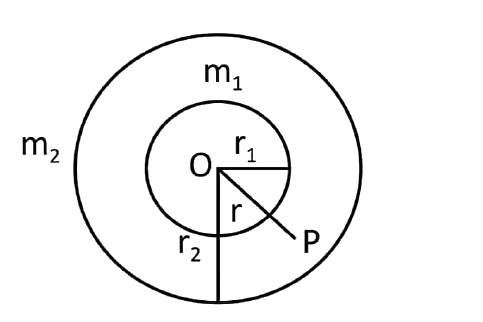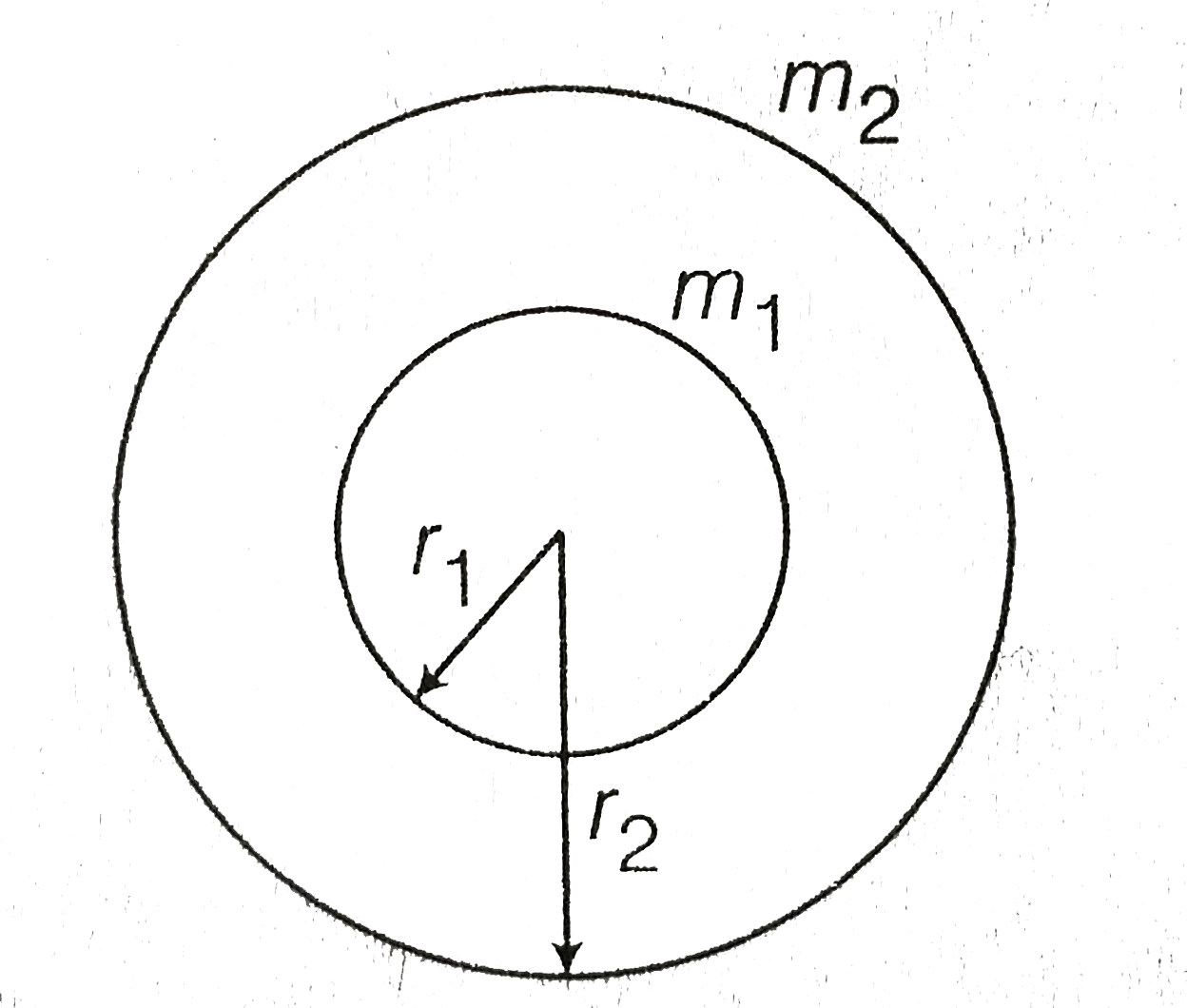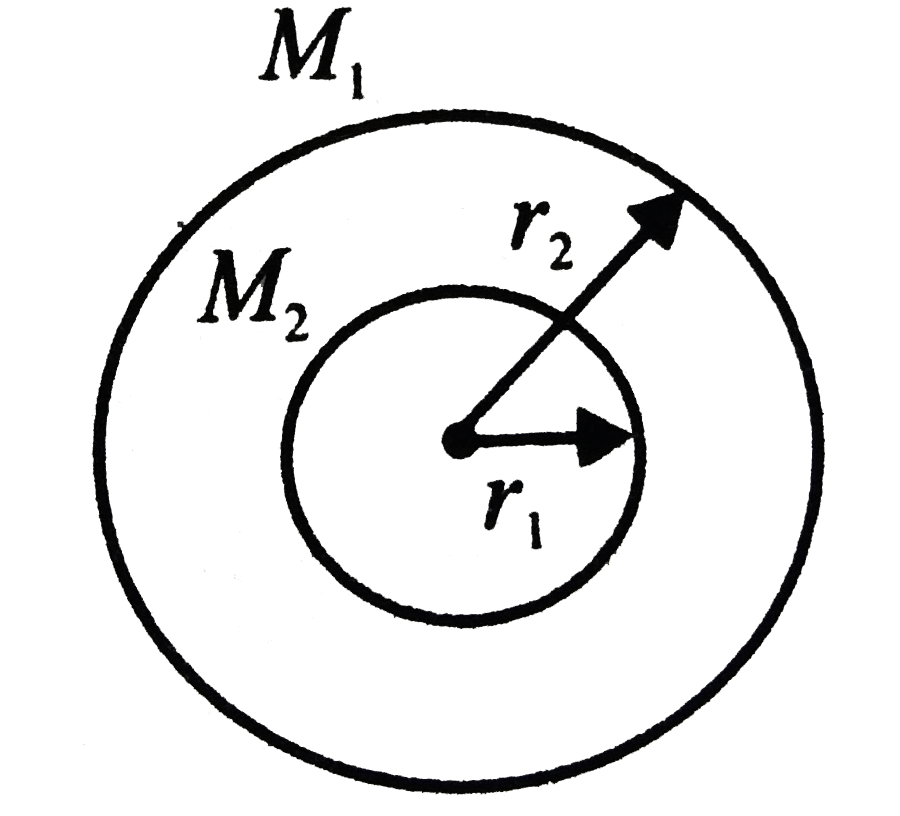Two concentric shells have masses M and m and their radii are R and r, respectively, where R>r. What is the gravitational potential at their common centre?
−GMR
−GMr
−G[MR−mr]
−G[MR+mr]
The correct Answer is:D
To find the gravitational potential at the common center of two concentric shells with masses M and m and radii R and r respectively, we can follow these steps:
Step 1: Understand the Gravitational Potential Formula
The gravitational potential V at a distance r from a mass m is given by the formula:
V=−Gmr
where G is the gravitational constant.
Step 2: Determine the Potential Due to Each Shell
1. Inner Shell: For the inner shell with mass m and radius r:
- Since we are at the center, the potential due to the inner shell is:
V1=−Gmr
2. Outer Shell: For the outer shell with mass M and radius R:
- Similarly, the potential due to the outer shell at the center is:
V2=−GMR
Step 3: Calculate the Total Gravitational Potential
The total gravitational potential V at the common center is the sum of the potentials due to both shells:
V=V1+V2
Substituting the expressions for V1 and V2:
V=−Gmr−GMR
Step 4: Combine the Terms
Factoring out −G:
V=−G(mr+MR)
Final Answer
Thus, the gravitational potential at the common center of the two concentric shells is:
V=−G(mr+MR)
---
The gravitational potential V at a distance r from a mass m is given by the formula:
V=−Gmr
where G is the gravitational constant.
1. Inner Shell: For the inner shell with mass m and radius r:
- Since we are at the center, the potential due to the inner shell is:
V1=−Gmr
- Similarly, the potential due to the outer shell at the center is:
V2=−GMR
The total gravitational potential V at the common center is the sum of the potentials due to both shells:
V=V1+V2
Substituting the expressions for V1 and V2:
V=−Gmr−GMR
Factoring out −G:
V=−G(mr+MR)
Thus, the gravitational potential at the common center of the two concentric shells is:
V=−G(mr+MR)
Topper's Solved these Questions
- GRAVITATIONBOOK - CENGAGE PHYSICS ENGLISHCHAPTER - GRAVITATIONEXERCISE - Multiple Correct
24 Videos
- GRAVITATIONBOOK - CENGAGE PHYSICS ENGLISHCHAPTER - GRAVITATIONEXERCISE - Assertion- Reasoning
13 Videos
- GRAVITATIONBOOK - CENGAGE PHYSICS ENGLISHCHAPTER - GRAVITATIONEXERCISE - Subjective
15 Videos
- FLUID MECHANICSBOOK - CENGAGE PHYSICS ENGLISHCHAPTER - FLUID MECHANICSEXERCISE - INTEGER_TYPE
1 Videos
- KINEMATICS-1BOOK - CENGAGE PHYSICS ENGLISHCHAPTER - KINEMATICS-1EXERCISE - Integer
9 Videos
Similar Questions
Two concentric spherical shells of masses and radii m1,r1andm2,r2 respectively are as shown. The gravitational field intensity at point P is

View SolutionTwo concentric conducting shells of radii R and 2R are having charges Q and -2Q respectively.In a region r
View SolutionTwo concentric spheres kept in air have radii R and r. They have similar charge and equal surface charge density σ. The electrical potential at their common centre is (where, ε0= permittivity of free space)
View SolutionAssertion : Two spherical shells have masses m1andm2. Their radii are r1andr2. Let r be the distance of a point from centre. Then gravitational field strength and gravitational potential both are equal to zero for O<r<r1

Reason : In the region r1<r<r2, gravitational field strength due to m2 is zero. But gravitational potential due to m2 is constant (but non-zero).
View Solution_E01_035_Q01.png)
There is a concentric hole of radius R in a solid sphere of radius 2R. Mass of the remaining portional is M. What is the gravitational potential at centre?
View SolutionTwo concentric spherical shells have masses m1andm2 and radii r1andr2(r2>r1). What is the force exerted by this system on a particle of mass m3. If it is placed at a distance r(r1<r<r2) from the centre ?
View SolutionTwo concentric shells of masses M1 and M2 are having radii r1 and r2. Which of the following is the correct expression for the gravitational field at a distance r ?
View SolutionTwo spherical bodies of masses m and 5m and radii R and 2R respectively, are released in free space with initial separation between their centres equal to 12 R. If they attract each other due to gravitational force only, the distance covered by smaller sphere just before collision is
View SolutionTwo concentric shells of masses M1 and M2 are having radii r1 and r2. Which of the following is the correct expression for the gravitational field on a mass m?

View SolutionTwo concentric shells of masses M1 and M2 are having radii r1 and r2. Which of the following is the correct expression for the gravitational field on a mass m?

View Solution

